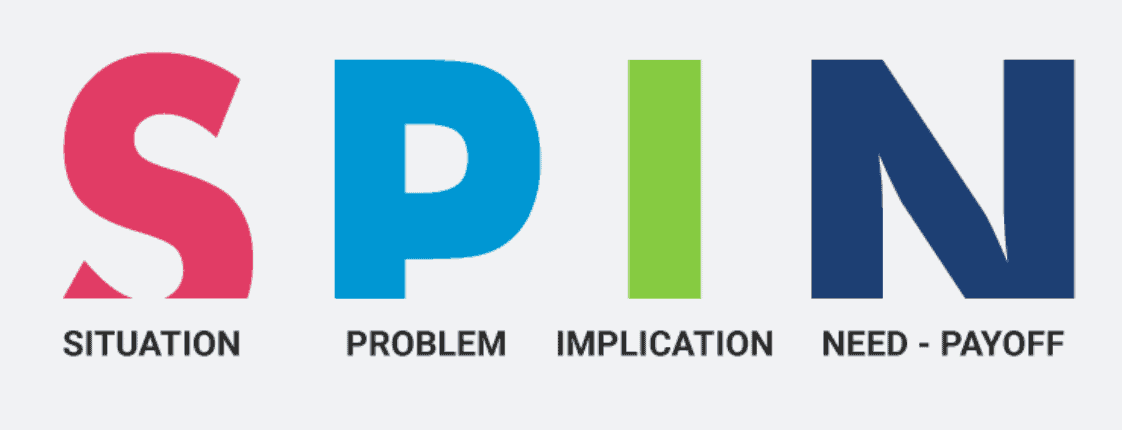Introduced in 1988 by Neil Rackham, a well-known author and consultant, the SPIN selling methodology helps sellers anticipate and respond to complex sales situations by asking the right questions to buyers.
The term SPIN stands for ‘situation, problem, implication, and need payoff’.
Over the past four decades, SPIN selling has proven to be one of the most effective ways of improving sales success and achieving bottom-line results.
In fact, salespersons trained in the SPIN selling methodology showed a 17% improvement in the sales results of a company.
In this post, we will talk about how SPIN selling works, the different stages of it, and some of the best practices for the same.
Table of Contents
How Does SPIN Selling Work?

The SPIN selling model works by applying four sets of questions – situation, problem, implication, and need payoff, at various stages of the sales cycle.
It is particularly useful for companies and products that have a lengthy sales cycle, multiple stakeholders, and a long implemented process.
In such scenarios, buyers are often unaware of their problems and how a product or service can help resolve them.
Using the right questions, sellers can figure out the customer’s needs and create a value proposition, urging them to make a purchase quickly.
So, how did SPIN selling come into existence?
It’s an interesting story.
In the 1970s, Neil Rackham was determined to answer the question ‘What sets the best salespeople apart from the pack?’
Almost a decade later, after conducting over 35,000 sales calls, Rackham and his team disproved several existing sales practices.
The biggest takeaway, however, was the quality of questions asked by salespersons to buyers.
While open-ended questions yielded little to no measurable results, good sales reps asked the right questions at the right time.
This helped Rackham develop an outline of questions to guide sales teams through any sales call, known as SPIN selling.
Read also: Cross-Selling Guide For Beginners (With Examples & Strategy)
The Four Stages of SPIN Selling
Let us find out more about the different stages of SPIN selling.
#1. Situation
The first stage in the SPIN selling process is the ‘situation.’
No two sales scenarios are the same – and thus, sales reps need to better understand the situation every individual customer is in.
It helps salespersons gather basic information about buyers, such as their current state, pain points, purchasing preferences, buying history, and so on.
This stage is the starting point of a sales rep’s conversation with prospective buyers as it helps them better understand their background.
Here are some questions you can ask your customers to get started.
Example of Situation Questions
- Tell me about your company.
- What products or services do you sell?
- Who is your target audience?
- What is your role at your company?
- Can you tell me about your current processes?
- What tools or solutions are you currently using to handle the ‘X’ problem or the ‘Y’ use case?
- What made you choose these solutions in the first place?
- What resources are allocated to this problem/use case?
- What are your priorities this quarter/year?
Read also: The Ultimate Guide to Cross-Functional Collaboration [+ Implementation]
#2. Problem
Once you are familiar with the buyer’s background, find out your client’s pain points and challenges.
The idea behind problem questions is to make your prospects aware of the problems that need to be addressed.
Of course, you are offering a solution to a certain set of problems.
But instead of pointing out their problems yourself, as a sales rep, you should pose questions that help clients identify the problems on their own.
Below is a set of questions you can ask from.
Examples of Problem Questions
- How important is solving the ‘X’ problem to your business?
- Do you believe this problem can be solved?
- Has your current approach ever failed?
- What are the major day-to-day challenges faced by your company?
- How does it impact your team’s work?
- How does it affect your clients and stakeholders?
- What barriers do you anticipate in making a decision? Implementing a solution? Getting users to embrace changes?
- What happens if you don’t solve the problem?
Read also: The Sales CHAMP Framework and How It Can Help Your Business
#3. Implication
Once you have identified the problems faced by your clients, the next step is to explore the consequences of the impact of the prospect’s problem.
During the implication phase, you need to demonstrate the possible impact of the issues faced by your client’s company on their performance, customers, and other stakeholders.
You need to then create a sense of urgency in addressing the pain points discussed during the problem stage.
However, even at this stage, you should avoid mentioning your product or service. Here too, the call is all about the customer and their needs.
Questions under the implication stage can be as follows.
Examples of Implication Questions
- How does the ‘X’ problem impact your work?
- Would solving the problem help your career?
- Has your current solution ever caused your business to miss out on important milestones or targets?
- How much budget are you spending on your current solutions?
- How much time do you and your time spend on implementing the solutions?
- If this problem did not exist, how would you use your budget or time differently?
- What goals are you unable to achieve because of this problem?
- If your company had more resources to solve the problem, how would you spend them?
Read also: 7 Tips For Turning Prospective Clients Into Paying Customers
#4. Need Payoff
The final stage of SPIN selling is ‘need payoff.’
The questions asked during this phase focus on the urgency and impact of solving the problem.
Here, your role is to figure out if solving the problem is a priority or not.
If yes, you need to quantify the impact of the solution on the client and their company. However, rather than describing to the client how your company can help address the pain points, need payoff questions allow your buyer to determine the solutions themselves.
Thus, instead of telling customers how your product can help them, ask questions that show the value or payoff of choosing your products and services.
Examples of Need Payoff Questions
- What would solving this problem mean for your business?
- How would finding a solution help you succeed in your role?
- How would finding a solution help your colleagues, partners, and subordinates?
- Would ‘X’ solution increase stakeholder buy-in?
- Would a comprehensive management tool help your team do A, B, and C?
- How would the solution be valuable for your team?
Read also: 6 Ways To Close The Deal With Less Persistence And More Influence
Best Practices for SPIN Selling

Here are some of the best practices for the successful implementation of the SPIN selling framework for sales teams.
#1. Have a Conversational Tone
Since the SPIN framework is about asking the right questions to buyers, it is important to keep them engaged.
Thus, you need to have a conversational tone while talking to prospective buyers and get to know them better.
The SPIN selling methodology trains sales reps to ask the relevant questions to customers so that they can help the latter identify the pain points and challenges faced by them rather than forcing them to make a purchase.
#2. Be an Active Listener
While asking the right questions is important, you need to be an active listener as well.
The SPIN selling technique encourages sellers to pose relevant questions while ensuring that the prospects have enough time to talk about themselves as well.
Therefore, it is better that the fewer questions you prepare, the better.
It will also help you gain deeper insights into your buyer’s persona and win more deals.
#3. Keep the Questions Open-Ended
Although open-ended questions have shown to yield very few positive results, asking a couple won’t affect your sales.
They will only create an opportunity for your prospects to describe their experience further and provide unexpected insights that can help close deals faster.
Read also: What Are Capital Goods? Definition, Importance, and Examples
#4. Use Other Sales Methodologies As Well
While the SPIN framework helps sales reps get a better idea of their buyers’ pain points, applying a range of other sales methodologies is useful.
Since the techniques used in the SPIN framework overlap with other methodologies, combining them only provides more tools and helps you create a strategy that aligns with your customers’ needs.
#5. Avoid Dominating the Conversation
To gain your buyer’s trust, ensure that you allow your buyer enough time and space to speak.
Hence, avoid dominating the conversation by not asking too many questions.
Make sure that your questions are short yet relevant and allow the client to provide valuable insights about themselves.
Further, try and paraphrase what your buyers said as it conveys that you were listening. It also helps build depth and meaningful relationships with your clients.
#6. Practice Well
As with any other sales framework, it is best to rehearse your questions before talking to clients.
This implies that you need to prepare a set of questions to ask beforehand and practice them.
It helps build confidence and is the key to flawless execution.
Moreover, you can add or remove any questions before asking them to your clients.
Read also: What is Social Selling? Benefits, Examples, Strategy, and Index
Wrap Up
A common mistake made by sales reps is they make the whole selling process a one-sided conversation.
But if you want to close a deal, you need to be empathetic towards your prospects and allow them to talk.
This is why SPIN selling is considered among the most effective sales methodologies in the market.
Through a set of questions, the SPIN framework helps sales reps determine the problems faced by customers and create a value proposition through their company’s products and services.
In essence, SPIN selling can go a long way in fostering strong and long-lasting relationships with buyers.
